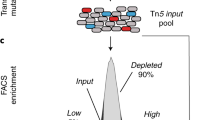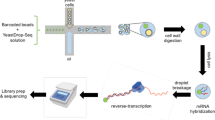Abstract
Since its invention in the early 1990s, differential display (DD) has become one of the most commonly used techniques for identifying differentially expressed genes at the mRNA level. Unlike other genomic approaches, such as DNA microarrays, DD systematically detects changes in mRNA profiles among multiple samples being compared without the need of any prior knowledge of genomic information of the living organism being studied. Here, we present an optimized DD protocol with a fluorescent digital readout as well as traditional radioactive labeling. The resulting streamlined fluorescent DD process offers an unprecedented accuracy, sensitivity and throughput in comprehensive and quantitative analysis of eukaryotic gene expression. Results usually can be obtained within days using a limited number of primer combinations, but a comprehensive DD screen may take weeks or months to accomplish, depending on gene coverage required and the number of differentially expressed genes present within a biological system being compared.
This is a preview of subscription content, access via your institution
Access options
Subscribe to this journal
Receive 12 print issues and online access
$259.00 per year
only $21.58 per issue
Buy this article
- Purchase on Springer Link
- Instant access to full article PDF
Prices may be subject to local taxes which are calculated during checkout





Similar content being viewed by others
References
Liang, P. & Pardee, A.B. Differential display of eukaryotic messenger RNA by means of the polymerase chain reaction. Science 257, 967–971 (1992).
Liang, P. A decade of differential display. Biotechniques 33, 338–346 (2002).
Liang, P. & Pardee, A.B. Analysing differential gene expression in cancer. Nat. Rev. Cancer 3, 869–876 (2003).
Cho, Y.-j. et al. Multicolor fluorescent differential display. Biotechniques 30, 562–572 (2001).
Bauer, D. et al. Identification of differentially expressed mRNA species by an improved display technique (DDRT-PCR). Nucleic Acids Res. 21, 4272–4280 (1993).
Liang, P. et al. Analysis of altered gene expression by differential display. Methods Enzymol. 254, 304–321 (1995).
Liang, P. et al. Differential display using one-base anchored oligo-dT primers. Nucleic Acids Res. 22, 5763–5764 (1994).
Liang, P., Averboukh, L. & Pardee, A.B. Method of differential display. in Methods in Molecular Genetics. (ed. Adolph, K.W.) 3–16 (Academic Press, San Diego, CA, 1994).
Yang, S. & Liang, P. Global analysis of gene expression by differential display—a mathematical model. Mol. Biotechnol. 27, 197–208 (2004).
Meade, J.D. et al. Automation of fluorescent differential display with digital readout. in Differential Display Methods and Protocols 2nd edn., Vol. 317 (eds. Liang, P., Meade, J.D. & Pardee, A.B.) 23–57 (Humana Press, Totowa, NJ, USA, 2005).
Liang, P., Averboukh, L. & Pardee, A.B. Distribution and cloning of eukaryotic mRNAs by means of differential display: refinements and optimization. Nucleic Acids Res. 21, 3269–3275 (1993).
Ausubel, F.M. et al. (eds.) Current Protocols in Molecular Biology (John Wiley & Sons, Somerset, NJ, USA, 2005).
Zhang, H., Zhang, R. & Liang, P. Differential screening of gene expression difference enriched by differential display. Nucleic Acids Res. 24, 2454–2455 (1996).
Schena, M., Shalon, D., Davis, R.W. & Brown, P.O. Quantitative monitoring of gene expression patterns with a complementary DNA microarray. Science 270, 467–470 (1995).
Chee, M. et al. Accessing genetic information with high-density DNA arrays. Science 274, 610–614 (1996).
Velculescu, V.E., Zhang, L., Vogelstein, B. & Kinzler, K.W. Serial analysis of gene expression. Science 270, 484–487 (1995).
Liang, P. Gene discovery using differential display. Genet. Eng. News 20, 37 (2000).
Liang, S. et al. Detection of an mRNA polymorphism by differential display. in Differential Display Methods and Protocols 2nd edn., Vol. 317 (eds. Liang, P., Meade, J.D. & Pardee, A.B.) 279–285 (Humana Press, Totowa, NJ, USA, 2005).
Author information
Authors and Affiliations
Corresponding authors
Ethics declarations
Competing interests
Peng Liang is the founder of GenHunter Corporation, and Jonathan Meade is employed by GenHunter Corporation, a biotechnology company with exclusive rights to the Differential Display technology for which it manufactures reagent based kits and provides service for differential display.
Rights and permissions
About this article
Cite this article
Liang, P., Meade, J. & Pardee, A. A protocol for differential display of mRNA expression using either fluorescent or radioactive labeling. Nat Protoc 2, 457–470 (2007). https://doi.org/10.1038/nprot.2007.46
Published:
Issue Date:
DOI: https://doi.org/10.1038/nprot.2007.46
This article is cited by
-
Alternative splicing directs two IL-20R2 isoforms and is responsible for the incomplete gene knockout via the exon I ablation
Genes & Immunity (2016)
-
Defense Transcriptome Analysis of Sugarcane and Colletotrichum falcatum Interaction Using Host Suspension Cells and Pathogen Elicitor
Sugar Tech (2016)
-
Cold stress alters transcription in meiotic anthers of cold tolerant chickpea (Cicer arietinum L.)
BMC Research Notes (2014)
-
Altered growth and root tip morphology in Pisum sativum L. in response to altered expression of a gene expressed in border cells
Plant and Soil (2014)
-
Transcriptomic effects of di-(2-ethylhexyl)-phthalate in Syrian hamster embryo cells: an important role of early cytoskeleton disturbances in carcinogenesis?
BMC Genomics (2011)
Comments
By submitting a comment you agree to abide by our Terms and Community Guidelines. If you find something abusive or that does not comply with our terms or guidelines please flag it as inappropriate.



